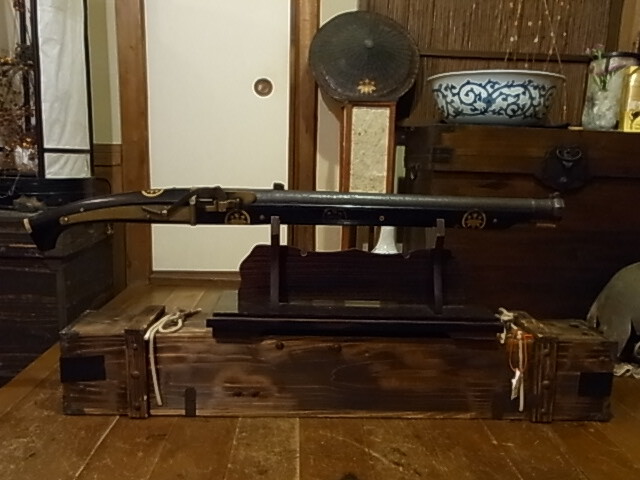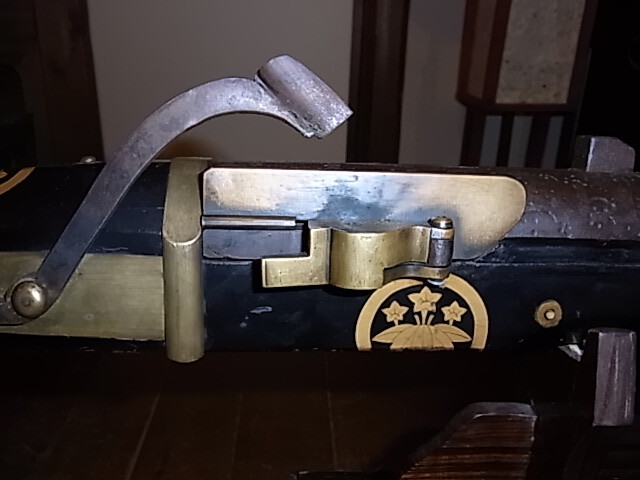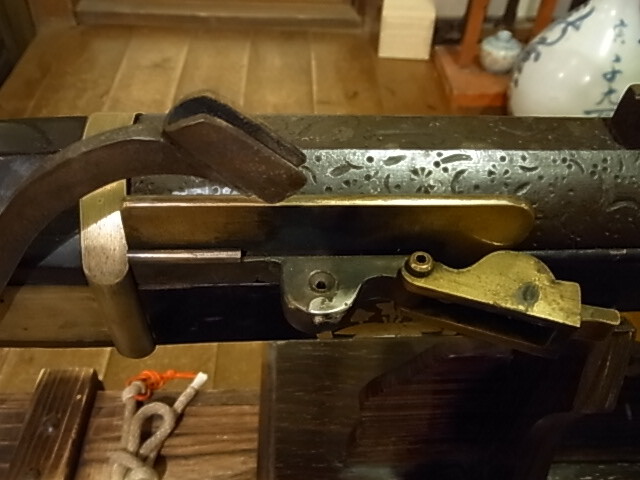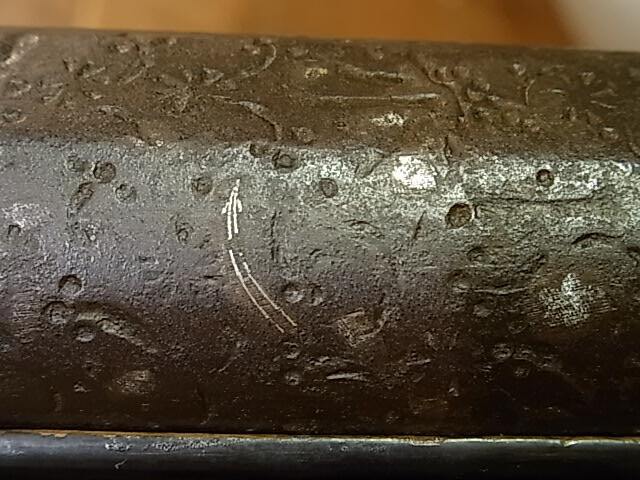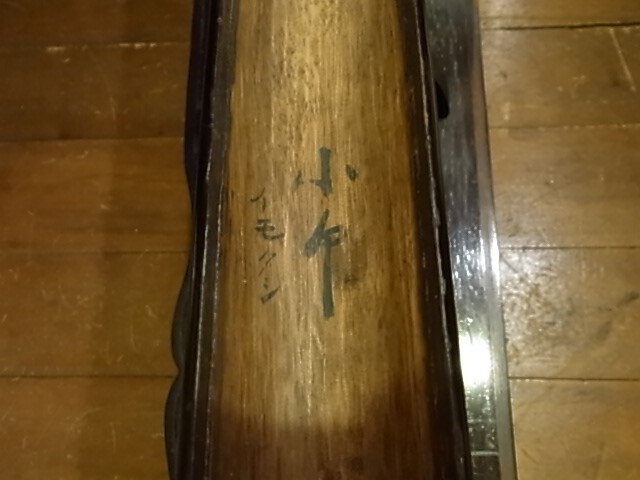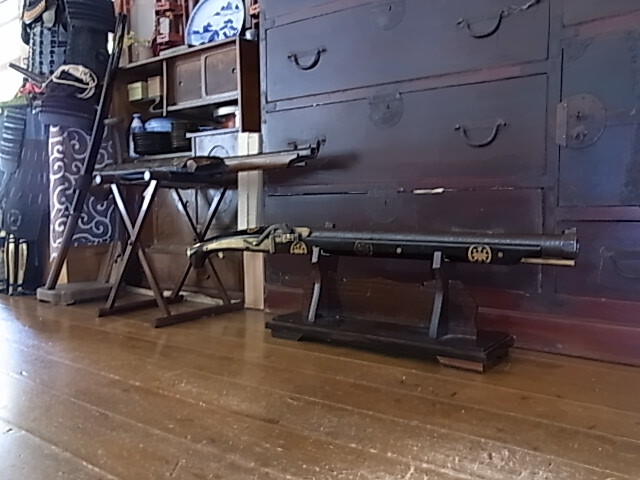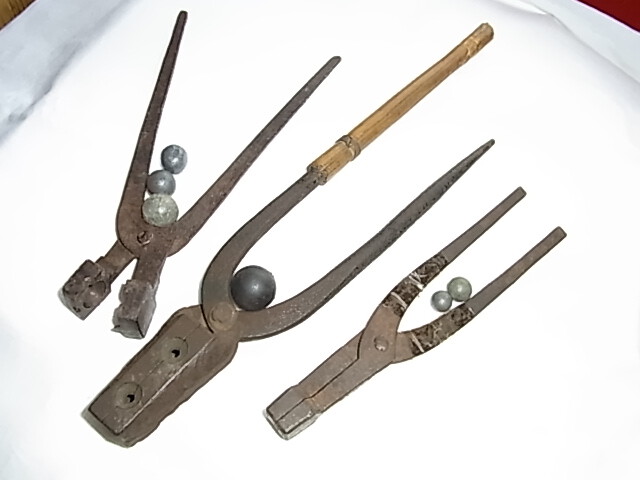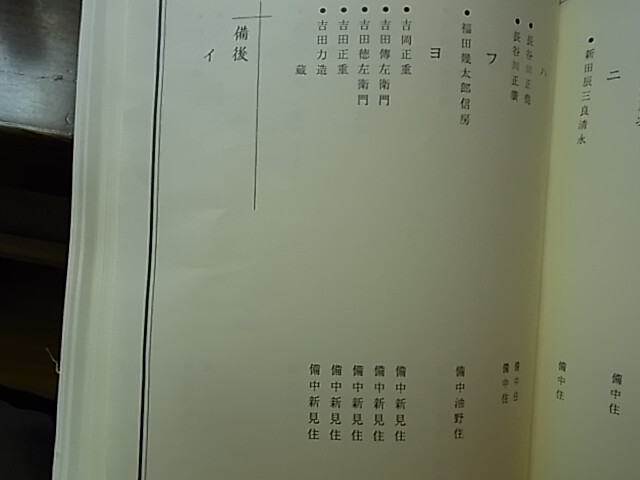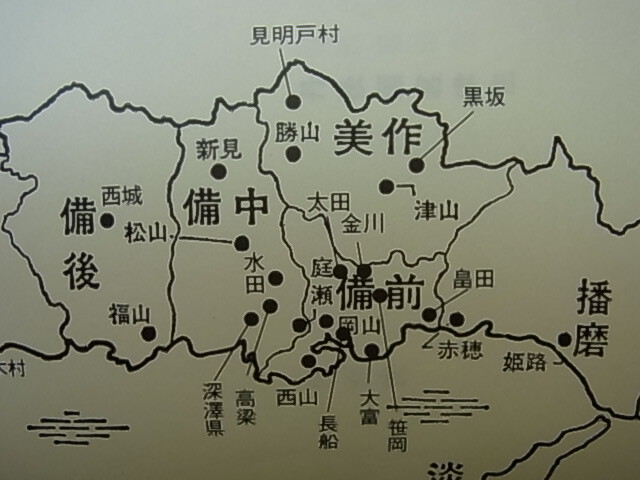-
Posts
13,648 -
Joined
-
Last visited
-
Days Won
245
Content Type
Profiles
Forums
Events
Store
Downloads
Gallery
Everything posted by Bugyotsuji
-
This is a 20 Monme Daimyo-dogu gun. Stock/butt is black lacquer with 7 Maki-e gold 'Sasa-lindo' Mon. The bore/caliber is 2.2cm. Overall gun length is 103.5cm; barrel length 69cm. Weight, 7.6 kg. Classified as an O-zutsu, or big gun, but at the lower end of O-zutsu. The gunnery school, or Ryu, is Tazuke, one of the original big 3 schools under Tokugawa Ieyasu, and is quite distinctive. You can tell Tazuke by the flat diagonal cut-off butt-end. Tazuke had various other distinguishing features, such as a 'covered' rain-proof panlid, unlike the two-story sandwich type we usually see, and in the beginning anyway, a rounded Bisen. Mine is missing the Kemuri-gaeshi, another general feature of Tazuke guns. This gun is unsigned. I have been told many things, such as Tazuke are often unsigned, and that Daimyo equipment is unsigned, etc, but what is the truth here? Without a Mei or a date, we have to work with other factors. The Mon are interesting. Sasa-lindo in a circle was used particularly by the Ishikawa Daimyo who lived in Kameyama Castle near Nagoya/Ise. In late Edo this family moved to Takahashi City in the north of Okayama. I spent some time looking for a link between Ishikawa and the Tazuke school and discovered that a famous teacher of this school, Honda Masashige, 1580-1647 with his son Masatsugu 1610-1627 served the Kaga Maeda family. In 1626 his grandson 朝政 (?) was born and they moved to Ise. At the age of 6 the son was adopted into the Ishikawa family and took their name. This is why I believe this gun may have been in Kameyama Castle at some time during the Edo Period. The barrel is covered in choji (clove) or daikon (radish) intaglio, with gold and silver zougan of leaves and flowers and pine needles spotted here and there, a bit like fireworks in the night sky. The tops of the sights are gold and silver zougan, but largely worn off. An intriguing thing then happened. Kinokuniya had an auction/sale No. 187 in 2006 and a very similar but smaller gun was offered and featured on the catalog front cover. The explanation says that it was owned by the Lord Matsudaira of Tosa and is connected with the Yamanouchi family. The price was silly, and I am convinced that mine is by far the better of the two guns, but who knows? Condition, fair. The middle side Mon are worn where the left hand grips the gun when shooting. The gun needs more TLC and I have done quite a bit already. The next step is to ask a lacquer worker to touch up the cracked or peeled spots in the lacquer.
-
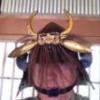
POSSIBLE BIZEN TANEGASHIMA with Sakai influence
Bugyotsuji replied to watsonmil's topic in Tanegashima / Teppo / Hinawajū
Note: I was just looking for a random photo of a Kemuri-gaeshi somewhere on the web. The site above is new to me and I know nothing about it, Eric. -

POSSIBLE BIZEN TANEGASHIMA with Sakai influence
Bugyotsuji replied to watsonmil's topic in Tanegashima / Teppo / Hinawajū
Look at the little brass partition/wall right behind the pan to stop blowback and protect your eyes/face. You will notice a groove in yours where it is missing. Click on 2nd from left of the 5 complex photos, and then the bottom gun pic. http://www.seiyudo.com/GU-098089.htm -

POSSIBLE BIZEN TANEGASHIMA with Sakai influence
Bugyotsuji replied to watsonmil's topic in Tanegashima / Teppo / Hinawajū
Thanks Eric for posting those. I was just curious to see how close your gun falls within the Bizen remit. This afternoon I was looking at a rack of 6 Bizen guns, and not one of them had all the attributes. Yours looks as though the original brass fittings have been plated at some point, but this plating has been largely removed by later cleaning. The pan lid and hinge-pin look to have been replaced, but it has been fired since then, and it is missing the Kemuri-gaeshi flashback protector aft of the pan. The pan is in very good condition as is the rest of it as far as I can see. The barrel is you say octagonal at the breech, all the way round? Have you had it out? Any Mei or date? -

POSSIBLE BIZEN TANEGASHIMA with Sakai influence
Bugyotsuji replied to watsonmil's topic in Tanegashima / Teppo / Hinawajū
Thomas, thank you. Ron, yes, I think I could summarize what I have found out about this gun so far. As you say, when time permits, but it could be an interesting job doing the write-up. As to the oil on wood question, this thread has now given me reason to consider maybe lightly oiling the insides of the stocks. Many old Tanegashima have splits alongside the stocks where the wood has shrunk alongside the barrel, but the metal has refused to shrink correspondingly. -

This Week's Edo Period Corner
Bugyotsuji replied to Bugyotsuji's topic in General Nihonto Related Discussion
Even with improved accuracy this Wiki answers article suggests that it took 3,000 bullets to wound one enemy combatant during the Vietnam War. As is "normal", figures will vary from year to year, and especially from source to source. But more often than not, the figures given closest to the date of occurrence appear to be the most accurate. During the early 1970's the figure of 3,000 rounds of small arms fire, per enemy casualty, was given. This had a profound effect on individual rifleman tactics. Shortly after these figures were accepted by the US Army, the M-16 rifle's full automatic switch was modified for short bursts. Until there is another change made, Vietnam will be the FIRST and LAST time in history in which the individual rifleman had "Rock an Roll" (full automatic capability). http://wiki.answers.com/Q/What_was_the_ ... ietnam_war -
Surely that has to be the -fune of Osafune, Dave??? Osafune an old, old word meaning the place of a longboat; Osa is an ancient Korean pronunciation of Naga- or Cho- (long).
-

POSSIBLE BIZEN TANEGASHIMA with Sakai influence
Bugyotsuji replied to watsonmil's topic in Tanegashima / Teppo / Hinawajū
-

This Week's Edo Period Corner
Bugyotsuji replied to Bugyotsuji's topic in General Nihonto Related Discussion
Lovely story, Ian, and for some reason totally believable. Bullet molds/moulds. Note the unusual double one from this morning. Large Hayago, one with Umebachi Mon. -

POSSIBLE BIZEN TANEGASHIMA with Sakai influence
Bugyotsuji replied to watsonmil's topic in Tanegashima / Teppo / Hinawajū
Eric, I wonder if you could take a shot or two including the pan and lid, open and closed. Thanks! -

This Week's Edo Period Corner
Bugyotsuji replied to Bugyotsuji's topic in General Nihonto Related Discussion
In massed attacking armies, you would only need to fire at the wall of advancing soldiers and your ball would surely hit something! Who hits whom might not be so important! I have just found some photographs of breech-loading Tanegashima(s), and a close-up shot of a bolt action Tanegashima. Today I had some luck at the antiques market. I found a couple of large bore Hayago, which was unusual as they do not come up too often. There was also a twin Tama-igata with two ball molds in the one head, a first for me. -

This Week's Edo Period Corner
Bugyotsuji replied to Bugyotsuji's topic in General Nihonto Related Discussion
I have only seen a couple of these here in Japan in recent years. They look a bit like butane bombs, or something! Probably designed to look like a miniature cannon. Size-wise and shape-wise, they could be used for a practical Netsuke, although they are a little heavy, but this would surely be a secondary function. The primary function would more likely be as you say as an eprouvette, with very little kick, and you could wear gloves or wind a cloth around it to avoid burns. They may even have had a rudimentary wooden rest/block/carriage originally. Netsuke-deppo or Teppo-Netsuke for display on a silk Obi would generally tend to be lighter, quite intricate, and decorated. -

POSSIBLE BIZEN TANEGASHIMA with Sakai influence
Bugyotsuji replied to watsonmil's topic in Tanegashima / Teppo / Hinawajū
Eric, apart from the (?) silverwashed serpentine and lock, your piece is almost 100% typical Bizen, at least what I can see from that distance, even down to the Kanmuri otoshi on the offside of the butt. (Fujioka-Ryu) Can you get a closer shot of the lock area? Although you do find brass, the Bizen lock is typically of iron/steel, but usually goes a dark rusty color/colour. Possibly someone in the West may have cleaned yours up in some way? As to the bolt action conversions, M. Jones, they are mentioned in Perrin's book, but you are perfectly right. A nightmare proposition. -

POSSIBLE BIZEN TANEGASHIMA with Sakai influence
Bugyotsuji replied to watsonmil's topic in Tanegashima / Teppo / Hinawajū
Have you posted a picture of your gun here before, Eric? Maybe we can help you narrow it down? Thomas, thanks for the recipe! Now, if I could just catch and milk one of those elusive Japanese moose... -

POSSIBLE BIZEN TANEGASHIMA with Sakai influence
Bugyotsuji replied to watsonmil's topic in Tanegashima / Teppo / Hinawajū
The book actually has a part II, at least in Japanese. I thought I had both books in J and both in E, but I've either misplaced Part II (E) or lent it to someone, or quite possibly my memory is playing tricks and there was never an English version of Pt II. There is a very shortened version on the web, Eric. Try , or if that doesn't work, misspell it and try "Japanease" for luck!!! Click on MATCHLOCKS http://japaneseweapons.com/ -

POSSIBLE BIZEN TANEGASHIMA with Sakai influence
Bugyotsuji replied to watsonmil's topic in Tanegashima / Teppo / Hinawajū
Eric must be referring to a warning that was posted here on the NMB a year or more ago about 'pure' clove oil ( a blue substance?) being terribly strong, so never to use that by mistake on your Nihonto. Normally-sold traditional clove oil however, the diluted version, is what has always been used apparently, and people should not go wrong. -

POSSIBLE BIZEN TANEGASHIMA with Sakai influence
Bugyotsuji replied to watsonmil's topic in Tanegashima / Teppo / Hinawajū
One of the causes of misfires is residual oil, so we have to be very careful as Ron says to clean it off before use. I use a whole range of gun oils I bought in the West, depending on my mood. A light gun oil seems good. Our members tend to use CRC 5-56 from Kure. Not quite sure why. http://www.kure.com/line_up/556/index.html What they used in Edo and before, Eric is a good question. I would suspect it might be something they would already have to hand, eg clove oil for cleaning/protecting swords. Perhaps Ron can answer this better. -

POSSIBLE BIZEN TANEGASHIMA with Sakai influence
Bugyotsuji replied to watsonmil's topic in Tanegashima / Teppo / Hinawajū
Astonishingly good description by Ron there, and in fact, despite doing this process every week 15 weeks a year, I learnt a couple of useful things from it. Many thanks. The only thing I might add, and this may be self-obvious, is that pouring scalding water down a funnel is a very dangerous job!!! You may want to position the barrel somewhere so that you do not need to touch it, and to wrap the barrel in a towel so that you can lift it and turn it round to pour the other way, and hold it steady while you ramrod it. The added benefit of the boiling water is that the residual heat evaporates all the rust-causing moisture out from inside the barrel, the touch hole and around the kusabi and ama-ooi. PS One further WARNING. Never forget to replace the breech plug. One of our members forgot during cleaning and reassembled his gun for a display. When the order was given to fire, much of the explosion went up into his right cheek and eye. He still has black freckles on his upper right cheek today. -

POSSIBLE BIZEN TANEGASHIMA with Sakai influence
Bugyotsuji replied to watsonmil's topic in Tanegashima / Teppo / Hinawajū
Certainly Ron, I can ask. I have connections to the people there. Nothing in the book though, sadly. All it says is Yoshida Rikizo (+ on left, alongside, Zo? = possession of) and down below Bichu Niimi Ju My 'boss' description above was not good. Typical Bizen-zutsu pins simply have silver heads, as you say. That sounds much better than the way I phrased it, and it would indeed be a nice touch to get your pins replated. -

POSSIBLE BIZEN TANEGASHIMA with Sakai influence
Bugyotsuji replied to watsonmil's topic in Tanegashima / Teppo / Hinawajū
The name on the far left is your gunsmith in Niimi. There was a line of gunsmiths there, and the Sakai influence was very strong. Collectors living in the Niimi area still keep an eye out for these when they turn up. On the map you can see the Sanyo-do. The central part is divided into Bizen, Bichu and Bingo, with Mimasaka above. You can see Niimi in the north of Bichu, at about 10:30 on the map. It is true that the whole area of present-day Okayama corresponds to a general appellation of Bizen, but not in the narrow sense. Just for readers who may be confused, the main indications of a Bizen gun are a dark lacquered stock, all-iron lock, kemuri-gaeshi, panlid and and serpentine, (though the inside of the panlid is lined with brass). The locking pins are usually headed with a silver boss. The muzzle is a smooth-surfaced Rakkyo pickled onion shape. There is often a kanmuri-otoshi cut-out along the top outside edge of the butt. -
The problem is, it depends who/what your audience is. Also, are you talking specifically about the 'kizami' themselves, or the Saya design, the general effect of the Saya? Many Japanese terms have no 'proper' English translation and are used in Englsih, with a supplementary word or two for clarification. If you are talking to people who know about Netsuke and Inro, then you can use the word Inro in your translation. The concept of Inro is quite well-known in the West. You can say something like 'Inro drawer design' or 'Inro section design', or 'Inro sections'. If, however, you want a general audience to understand, but you want to keep the idea of Inro in there, then you have a larger problem, and your translation might include some description, so that it becomes quite long. You might want to say that the saya is in "Inro design, ie marked off (delineated) in sections like in a Japanese hanging Inro medicine container". Or you can avoid the problem completely and go for something like Ron's translation above, IMHO.
-

This Week's Edo Period Corner
Bugyotsuji replied to Bugyotsuji's topic in General Nihonto Related Discussion
Many thanks Eric. Noel Perrin takes a rather extreme position with which some people disagree, but his book is well worth reading. Food for thought. I must go back and read my copy again! Interestingly, in light of Mr Jones above mentioning Western 'threaded breech plugs', the Japanese word Bisen actually means 'tail plug' even though it is threaded as a giant screw. -
Over use of the word 'authentic' tends to drive me away. Some things on that site are... well, but the box you mention does look genuine.
-
Many thanks everyone for your replies, with some fresh angles on this. A child? Hmmm... .
-
Thanks John. Just inquiring for a friend in need!


